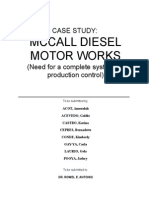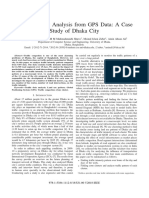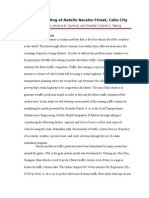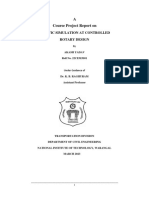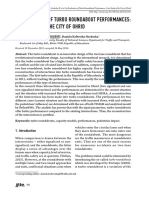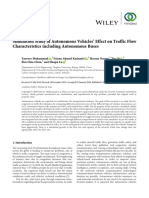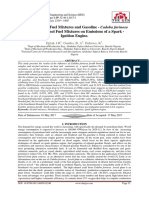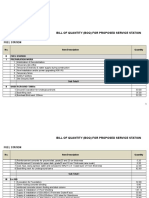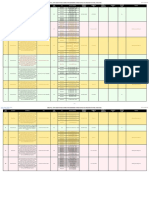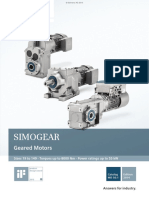0 ratings0% found this document useful (0 votes)
22 viewsAnalysis and Development of Traffic Stream Parameters of Heterogeneous Traffic at Signalized Intersection
Analysis and Development of Traffic Stream Parameters of Heterogeneous Traffic at Signalized Intersection
Uploaded by
theijesThe International Journal of Engineering & Science is aimed at providing a platform for researchers, engineers, scientists, or educators to publish their original research results, to exchange new ideas, to disseminate information in innovative designs, engineering experiences and technological skills. It is also the Journal's objective to promote engineering and technology education. All papers submitted to the Journal will be blind peer-reviewed. Only original articles will be published.
The papers for publication in The International Journal of Engineering& Science are selected through rigorous peer reviews to ensure originality, timeliness, relevance, and readability.
Theoretical work submitted to the Journal should be original in its motivation or modeling structure. Empirical analysis should be based on a theoretical framework and should be capable of replication. It is expected that all materials required for replication (including computer programs and data sets) should be available upon request to the authors.
Copyright:
© All Rights Reserved
Available Formats
Download as PDF, TXT or read online from Scribd
Analysis and Development of Traffic Stream Parameters of Heterogeneous Traffic at Signalized Intersection
Analysis and Development of Traffic Stream Parameters of Heterogeneous Traffic at Signalized Intersection
Uploaded by
theijes0 ratings0% found this document useful (0 votes)
22 views7 pagesThe International Journal of Engineering & Science is aimed at providing a platform for researchers, engineers, scientists, or educators to publish their original research results, to exchange new ideas, to disseminate information in innovative designs, engineering experiences and technological skills. It is also the Journal's objective to promote engineering and technology education. All papers submitted to the Journal will be blind peer-reviewed. Only original articles will be published.
The papers for publication in The International Journal of Engineering& Science are selected through rigorous peer reviews to ensure originality, timeliness, relevance, and readability.
Theoretical work submitted to the Journal should be original in its motivation or modeling structure. Empirical analysis should be based on a theoretical framework and should be capable of replication. It is expected that all materials required for replication (including computer programs and data sets) should be available upon request to the authors.
Original Title
g 03502033039
Copyright
© © All Rights Reserved
Available Formats
PDF, TXT or read online from Scribd
Share this document
Did you find this document useful?
Is this content inappropriate?
The International Journal of Engineering & Science is aimed at providing a platform for researchers, engineers, scientists, or educators to publish their original research results, to exchange new ideas, to disseminate information in innovative designs, engineering experiences and technological skills. It is also the Journal's objective to promote engineering and technology education. All papers submitted to the Journal will be blind peer-reviewed. Only original articles will be published.
The papers for publication in The International Journal of Engineering& Science are selected through rigorous peer reviews to ensure originality, timeliness, relevance, and readability.
Theoretical work submitted to the Journal should be original in its motivation or modeling structure. Empirical analysis should be based on a theoretical framework and should be capable of replication. It is expected that all materials required for replication (including computer programs and data sets) should be available upon request to the authors.
Copyright:
© All Rights Reserved
Available Formats
Download as PDF, TXT or read online from Scribd
Download as pdf or txt
0 ratings0% found this document useful (0 votes)
22 views7 pagesAnalysis and Development of Traffic Stream Parameters of Heterogeneous Traffic at Signalized Intersection
Analysis and Development of Traffic Stream Parameters of Heterogeneous Traffic at Signalized Intersection
Uploaded by
theijesThe International Journal of Engineering & Science is aimed at providing a platform for researchers, engineers, scientists, or educators to publish their original research results, to exchange new ideas, to disseminate information in innovative designs, engineering experiences and technological skills. It is also the Journal's objective to promote engineering and technology education. All papers submitted to the Journal will be blind peer-reviewed. Only original articles will be published.
The papers for publication in The International Journal of Engineering& Science are selected through rigorous peer reviews to ensure originality, timeliness, relevance, and readability.
Theoretical work submitted to the Journal should be original in its motivation or modeling structure. Empirical analysis should be based on a theoretical framework and should be capable of replication. It is expected that all materials required for replication (including computer programs and data sets) should be available upon request to the authors.
Copyright:
© All Rights Reserved
Available Formats
Download as PDF, TXT or read online from Scribd
Download as pdf or txt
You are on page 1of 7
The International Journal Of Engineering And Science (IJES)
|| Volume || 3 || Issue || 5 || Pages || 33-39 || 2014 ||
ISSN (e): 2319 1813 ISSN (p): 2319 1805
www.theijes.com The IJES Page 33
Analysis and Development of Traffic Stream Parameters of
Heterogeneous Traffic at Signalized Intersection
R.S. Dhapudkar
M-tech Transportation, Civil Engineering Department, GHRCE, Nagpur, Maharashtra, India
--------------------------------------------------------------ABSTRACT---------------------------------------------------
The rapid increase in the volume of traffic in most of the countries containing the heterogeneous traffic demands
a more efficient and intelligent system to be dealt with. A heterogeneous traffic stream consists of vehicles that
have different speeds, sizes, operating characteristics, and vehicle spacing. The Indian traffic is heterogeneous
traffic. Homogeneous design methods do not fit the heterogeneous situation, especially in non-lane-based
roadways that populate the developing world. This paper reviews the status of heterogeneous mixes worldwide,
and what factors need to be considered in such mixes. This paper presents a macroscopic stochastic model of
traffic movements at signalized intersection. To study macroscopic traffic parameters (flow, speed and density)
and to establish new models for the Indian highway. A heterogeneous traffic stream consists of vehicles that have
different speeds, sizes, operating characteristics, and vehicle spacing. It reviews the status of heterogeneous
mixes world traffic, and which factors need to be considered in such traffic. The Indian roads are constructed on
European equation of homogeneous traffic and different LOS, which are not applicable to heterogeneous traffic
of India. So, there is a need to model the new equation for Indian highways. In these traffic parameters were
identified by using the video recording technique at just after the signalized intersection. And found out the
relation between macroscopic parameters of traffic and compared with the fundamental diagrams. SPSS software
is used to define the relationship between the traffic parameters.
KEYWORDS: - Signalized intersection, Flow, density, speed, heterogeneous traffic, traffic flow etc...
----------------------------------------------------------------------------------------------------------------------------------------
Date of Submission: 02 May 2014 Date of Publication: 15 May 2014
----------------------------------------------------------------------------------------------------------------------------------------
I. INTRODUCTION
India is the fifth largest automobile manufacturer in the world. The development of highway
infrastructure and the transport sector have subsequently been receiving a much goes on increasing. The National
highways run across the length and breadth of the country measure 70,934 kilometers and have become the
lifeline of India.
A heterogeneous traffic stream consists of vehicles that have different speeds, sizes, operating
characteristics, and vehicle spacing. The Indian traffic is heterogeneous traffic. Homogeneous design methods do
not fit the heterogeneous situation, especially in non-lane-based roadways that populate the developing world.
This paper reviews the status of heterogeneous mixes world traffic, and which factors need to be considered in
such traffic. The issues of safety, modeling, and non-motorized transport are considered, and solutions for these
are discussed. These are important because the need for an understanding of heterogeneous mixes will grow in
the future due to their presence in developing world mega cities and growth in the developed world.
Intersection may be signalized for a number of reasons, most of which relate to the safety and effective
movement of conflicting vehicular and pedestrian flows through intersection. The level of service (LOS) of India
is A. The Indian roads are constructed on European equation of homogeneous traffic and different LOS, which
are not applicable to heterogeneous traffic of India. So, we have to construct new model for Indian highways.
II. CONTINUITY EQUATION FOR HOMOGENEOUS TRAFFIC
Density is calculated by using continuity equation (Gerlough and Huber 1975), as follows,
K=q/u (1)
Analysis and Development of Traffic Stream Parameters of
www.theijes.com The IJES Page 34
Where, k= traffic density in lanes in vehicles/km.
q=traffic flow across the lane in a vehicle/hr.
u=weighted average speed in km/hr.
III. EXISTING TRAFFIC STREAM MODELS
To figure out the exact relationship between the traffic parameters, lots of researches is carried out over
the past several decades. The result of these researches yielded many mathematical models. Some important
model amount them are discussed below.
Green shields macroscopic stream model (1935)
Relation between speed and density:-
Macroscopic stream models represent how the behavior of one parameter of traffic flow changes with respect to
another. The first and most simple relation between them is proposed by Green shield (TRB Monograph). Green shield
assumed a linear speed-density relationship as illustrated in figure 1 to derive the model.
The equation for this relationship is shown below.
Fig-1: Relation between Speed and Density
This relationship is described using equation 1.
Where, v =mean speed, m/s
k = density corresponding to speed (veh/m)
v
f
=free flow speed (m/s)
k
j
=jam density (veh/m)
This equation is often referred to as the Greenshield model. It indicates that when density becomes zero, speed
approaches free flow speed (i.e. v v
f
when k 0).
Relation between speed and flow
Fig-2: Relation between speed and flow
Analysis and Development of Traffic Stream Parameters of
www.theijes.com The IJES Page 35
Relation between flow and density
Fig-3: Relation between flow and density
Limitations
In order to use this model for any traffic stream, one should get the boundary values, especially free flow speed
(v
f
) and jam density (k
j
). But it is difficult to determine exact free flow speed and jam density directly from the
field. In Green shield model, linear relationship between speed and jam density was assumed. But in field one
can hardly find such a relationship between speed and density. Therefore, the validity of Green shield model was
questioned and Greenbergs model has come up.
Greenberg's logarithmic model (1959)
Greenberg assumed a logarithmic relation between speed and density.
Fig-4: Greenberg's logarithmic model
Greenberg has given the following equation,
Limitation:
A main drawback of this model was that as density tends to become 0 (zero), speed tends to infinity. This shows
the inability of the model to predict the speed at lower densities which puts forward a new model.
Analysis and Development of Traffic Stream Parameters of
www.theijes.com The IJES Page 36
Underwood's exponential model (1971)
Trying to overcome the limitation of Greenberg's model, Underwood put forward an exponential model as shown
below.
Fig-5: Underwood's exponential model
Where , v
f
= free flow speed
k
o
is the optimum density, i.e. the density corresponding to the maximum flow.
In this model, speed becomes zero only when density reaches infinity which is the drawback of this model.
Hence this cannot be used for predicting speeds at high densities.
IV. DATA COLLECTION AND PROCESSING
Traffic data was collected on Nagpur roadways section at three intersections i.e. at pratap nagar square,
RBI square and Ravi nagar square in Nagpur city. The data was collected by using digital video camera. A 35m
length was marked on roadway section to locate the distance travelled and to record time taken by vehicle to
travel the 35m distance to calculate the speed.
Fig-6. 35m marking on road
Sr. No. Types of vehicles
1 Heavy vehicle
2 Big car
3 Small car
4 Three wheelers
5 Two wheelers
Analysis and Development of Traffic Stream Parameters of
www.theijes.com The IJES Page 37
Table -2: Sample data of Pratap nagar square
This covered peak flow and off peak flow condition. The time required by each vehicle to cover the distance of
35m was recorded from the video clip and the number of vehicles of each entity type crossing a particular section
in 5 minute was recorded.
V. ANALYSIS AND RESULT
Fig-6: Speed-Flow Curve
Analysis and Development of Traffic Stream Parameters of
www.theijes.com The IJES Page 38
Fig-7: Speed-Density Curve
Fig-8: Flow-Density Curve
VI. MATHEMATICAL MODEL
In this study it is observed that the data points in congestion region do not exist. This is due to lesser no.
of vehicles utilizing facility. Hence the data points on congested or infeasible region are not observed. By using
SPSS software, we find out the correlation between traffic stream parameters of observed data. And we get the
following regression equations:
Flow-Density relationship:-
k = 0.046q 19.331 (1)
Speed-Density relationship:-
k = -4.6334u
s
190.397 (2)
Speed-flow relationship:-
k= q/u
s
Therefore eq
n
(2) becomes,
q= -4.633u
s
2
1190.397u
s
(3)
Analysis and Development of Traffic Stream Parameters of
www.theijes.com The IJES Page 39
Density is the dependent variable and speed and flow are independent variable. Flow-density curve and
speed-density curve shows the linear relationship and we get non-linear regression model. Ve sign in flow-
speed equation shows the negative behavior of the curve.
Speed-Flow-Density relationship is given by
k = 0.034*q 1.334*u
s
+ 38.647 (4)
Where, k= traffic density in lanes in vehicles/km.
q=traffic flow across the lane in a vehicle/hr.
u
s
=weighted average speed in km/hr.
VII.
CONCLUSION
From the survey we find out that our Indian traffic is heterogeneous traffic. It is concluded that existing equation of
traffic stream are not suitable for these Heterogeneous traffic. Thus we need to create new equation for this Heterogeneous
traffic of Indian scenario. According to our complete analysis we found the traffic stream parameters. We get standard
relationship between traffic stream parameters. We get a simple regression equation for heterogeneous traffic of Nagpur city.
REFERENCES:-
[1] Fazio, J., and Tiwari, G. (1995). Nonmotorized & Motorized traffic accidents and conflicts on Delhi streets. Transportation
Research Record.1487, Transportation Research Board, Washi2013ngton, D.C., 6874.
[2] Gerlough, D. L., and Huber, M. J. (1975). Traffic flow theory: A monograph.Special Rep. No. 165, Transportation Research
Board, National Research Council, Washington, D.C
[3] Krishna rao K. V. (may 8,2007) introduction to traffic Engineering Chapter 33, Traffic Stream model, NPTEL
[4] Lindsey, C.R.; Verhoef, E.T. (1999). Congestion Modeling, Tinbergen Institute Discussion Papers 99-091/3, Tinbergen Institute.
[5] Maria de Lurdes Simes et al (1943) Modeling and Simulation of Traffic Movements at Semiactuated Signalized
Intersections10.1061/(ASCE)TE.-5436.0000124
[5] Mathew V. (2010-12-10) Traffic stream Models Lecture Notes on Transportation System Engineering.
[6] Singh, R. (1999). Improved Speed-Flow Relationships: Application to Transportation Planning Models. Paper Presented at the 7th
TRB Conference on Application of Transportation Planning Methods, Boston, Massachusetts.
[7] ThamizhArasan V. and Vedagiri P. (December 2009) Stimulating Heterogeneous Traffic Flow on Road With or Without Traffic
Lanes Journal of Infrastructure Systems, Vol.15, No. 4.305.
[8] Tohti G. et al (2013), Traffic Flow Modeling and Simulation of Signalized Intersections. National Natural Science Foundation of
China (81160458) and (11072209)
[9] Transportation Research Board 2001. Highway Capacity Manual 2000. 500 Fifth St. NW, Washington, D.C.1776/2001: 1-9.
[10] Wardrop, J. G. (1952). Some theoretical aspects of road traffic research.Proc., Institution of Civil Engineers, Part II, Vol. I, 325
362.
[11] Waseem Akram (10 august, 2010) Greensheilds And Greenbergs Model Matric No. 092-90-4968
You might also like
- Mccall Diesel Motor Works Case StudyDocument14 pagesMccall Diesel Motor Works Case StudyKimberlyConde100% (2)
- Box Culvert Structural Design Report TemplateDocument10 pagesBox Culvert Structural Design Report Templaterhon100% (1)
- Development of Traffic Flow Model On Suburban RoadDocument8 pagesDevelopment of Traffic Flow Model On Suburban RoadRupayan MondalNo ratings yet
- A Review of The Difference Among Macroscopic, Microscopic and Mesoscopic Traffic ModelsDocument17 pagesA Review of The Difference Among Macroscopic, Microscopic and Mesoscopic Traffic ModelsFrancisco GranadosNo ratings yet
- Estimation of Saturation Flow and PCU at Intersection With Platoon Dispersion ModelDocument7 pagesEstimation of Saturation Flow and PCU at Intersection With Platoon Dispersion ModelIJSTENo ratings yet
- Paper TR31 0610045112Document11 pagesPaper TR31 061004511201,CE-11th Tasneem Ahmed ShuvoNo ratings yet
- Effect of Vehicle Composition and Delay On Roundabout Capacity Under Mixed Traffic ConditionsDocument8 pagesEffect of Vehicle Composition and Delay On Roundabout Capacity Under Mixed Traffic ConditionsasdNo ratings yet
- Effect of Road Width and Traf Fic Volume On Vehicular Interactions in Heterogeneous Traf FicDocument14 pagesEffect of Road Width and Traf Fic Volume On Vehicular Interactions in Heterogeneous Traf FicRajaSekhararayudu SanaNo ratings yet
- Sciencedirect: Traffic Analysis of Srinagar CityDocument13 pagesSciencedirect: Traffic Analysis of Srinagar CityAzhArRafIqNo ratings yet
- Cover Page - NothingDocument4 pagesCover Page - Nothingupasara_wulung_1980No ratings yet
- 14 Multilane HighwayDocument8 pages14 Multilane HighwayJagadish JocNo ratings yet
- Development of Traffic Flow Model On Suburban RoadDocument21 pagesDevelopment of Traffic Flow Model On Suburban RoadRupayan MondalNo ratings yet
- Saturation Flow Rate Analysis at Signalized Intersections For Mixed Traffic Conditions in Motorcycle Dependent CitiesDocument15 pagesSaturation Flow Rate Analysis at Signalized Intersections For Mixed Traffic Conditions in Motorcycle Dependent CitiesCris Audrey Pacheco BlancoNo ratings yet
- Capacity Estimation of 4-Lane DividedDocument8 pagesCapacity Estimation of 4-Lane DividedSanjay GargNo ratings yet
- 11Document1 page11Punith B KotagiNo ratings yet
- Ijirstv2i1077 PDFDocument7 pagesIjirstv2i1077 PDFVishal JainNo ratings yet
- Ijirstv2i1077 PDFDocument7 pagesIjirstv2i1077 PDFVishal JainNo ratings yet
- A Queueing Based Traffic Flow ModelDocument23 pagesA Queueing Based Traffic Flow ModelTanuj VermaNo ratings yet
- Modelling Congestion On Urban Roads Using Speed Profile DataDocument10 pagesModelling Congestion On Urban Roads Using Speed Profile DataSuhas RamachandraNo ratings yet
- Literature ReviewDocument11 pagesLiterature ReviewRegie Wengkyu HugoNo ratings yet
- Traffic State Estimation and Prediction Underheterogeneous Traffic ConditionsDocument5 pagesTraffic State Estimation and Prediction Underheterogeneous Traffic ConditionsIDESNo ratings yet
- Analysis of Work Zone Traffic Behavior For Planning ApplicationsDocument18 pagesAnalysis of Work Zone Traffic Behavior For Planning Applicationsanubhavchattaraj337No ratings yet
- Modelling of Turning Traffic Volume in Ibadan, Nigeria Using Linear and Hybrid Furness-Fratar TechniquesDocument8 pagesModelling of Turning Traffic Volume in Ibadan, Nigeria Using Linear and Hybrid Furness-Fratar TechniquesIOSRJEN : hard copy, certificates, Call for Papers 2013, publishing of journalNo ratings yet
- Capacity Analysis Under Mixed Traffic ConditionsDocument5 pagesCapacity Analysis Under Mixed Traffic ConditionsVenkata Swathi Reddy DumpaNo ratings yet
- Poli 140907065955 Phpapp01 PDFDocument8 pagesPoli 140907065955 Phpapp01 PDFMehdi FarrokhiNo ratings yet
- VANET Connectivity Analysis: Mohamed Kafsi, Panos Papadimitratos, Olivier Dousse, Tansu Alpcan, Jean-Pierre HubauxDocument10 pagesVANET Connectivity Analysis: Mohamed Kafsi, Panos Papadimitratos, Olivier Dousse, Tansu Alpcan, Jean-Pierre HubauxThiruChNo ratings yet
- Video-Based Detection and Tracking Model For Traffic SurveillanceDocument17 pagesVideo-Based Detection and Tracking Model For Traffic SurveillanceHashem EL-MaRimeyNo ratings yet
- Traffic Pattern Analysis From GPS Data: A Case Study of Dhaka CityDocument6 pagesTraffic Pattern Analysis From GPS Data: A Case Study of Dhaka CityheimdhallNo ratings yet
- Review 1Document11 pagesReview 1Anonymous gfbLDQPgNo ratings yet
- A Review On Capacity and Level of Service For Urban Road-IJAERDV04I0246171Document3 pagesA Review On Capacity and Level of Service For Urban Road-IJAERDV04I0246171Editor IJAERDNo ratings yet
- Research ProposalDocument7 pagesResearch Proposaljeany noquillo50% (2)
- Freeway Weaving: Comparing The HCM 2000 and Dutch GuidelinesDocument23 pagesFreeway Weaving: Comparing The HCM 2000 and Dutch GuidelinesradovicnNo ratings yet
- Traffic Engineering and FlowDocument6 pagesTraffic Engineering and Flowdareymayree56No ratings yet
- Batch 10 - 22cem3s01Document23 pagesBatch 10 - 22cem3s01AkashNo ratings yet
- Simulated Capacity of Roundabouts and Impact of Roundabout Within A Progressed Signalized RoadDocument24 pagesSimulated Capacity of Roundabouts and Impact of Roundabout Within A Progressed Signalized RoadpradeepNo ratings yet
- Literature Review Traffic Volume StudyDocument8 pagesLiterature Review Traffic Volume Studyea219sww100% (1)
- Empirical MFDs Using Google Traffic DataDocument8 pagesEmpirical MFDs Using Google Traffic Datamanmaga46No ratings yet
- Existence of Urban-Scale Macroscopic FundamentalDocument12 pagesExistence of Urban-Scale Macroscopic Fundamentalhuangtao2001No ratings yet
- Moving Vehicle Method To Calculate Traffic Flow CHDocument10 pagesMoving Vehicle Method To Calculate Traffic Flow CHwhg.jihanNo ratings yet
- Intro 2Document8 pagesIntro 2Jerle Mae ParondoNo ratings yet
- ROTONDASDocument16 pagesROTONDASsercifer912No ratings yet
- Traffic Flow AnalysisDocument8 pagesTraffic Flow AnalysisMonika AcharyaNo ratings yet
- Heterogeneous Traffic Ow Modelling: A Complete Methodology: Transportmetrica September 2011Document26 pagesHeterogeneous Traffic Ow Modelling: A Complete Methodology: Transportmetrica September 2011Mahindra DeshmukhNo ratings yet
- Unit 3Document41 pagesUnit 3B.RojaNo ratings yet
- 2021 - Simulation Study of Autonomous Vehicles' Effect On Traffic Flow Characteristics Including Autonomous Buses 4318652Document17 pages2021 - Simulation Study of Autonomous Vehicles' Effect On Traffic Flow Characteristics Including Autonomous Buses 431865227051995No ratings yet
- Examining Queue-Jumping Phenomenon in Heterogeneous Traffic Stream at Signalized Intersection Using UAV-based DataDocument16 pagesExamining Queue-Jumping Phenomenon in Heterogeneous Traffic Stream at Signalized Intersection Using UAV-based Datasaurabhh JNo ratings yet
- Fundamental Principles of Traffic Flow Traffic Flow TheoryDocument4 pagesFundamental Principles of Traffic Flow Traffic Flow TheoryGerly Joy MaquilingNo ratings yet
- Dr. A. Gowri: EducationDocument6 pagesDr. A. Gowri: EducationTeuku Maulana AnsariNo ratings yet
- S. Anand and V.C SekharDocument8 pagesS. Anand and V.C Sekharshlokshah2006No ratings yet
- A Model To Reduce Traffic Congestion in Colombo CiDocument7 pagesA Model To Reduce Traffic Congestion in Colombo CiLiki ThanNo ratings yet
- Simulation Building ModelDocument3 pagesSimulation Building ModelaminaNo ratings yet
- 386 1492 1 PBDocument14 pages386 1492 1 PBmanqele2008No ratings yet
- TRL908 R1Document74 pagesTRL908 R1Januka HumagainNo ratings yet
- Satyajit MondalDocument16 pagesSatyajit MondalSwagata SarkarNo ratings yet
- Traffic Volume Study Term PaperDocument7 pagesTraffic Volume Study Term Paperbujuj1tunag2100% (1)
- Article AJSSDocument10 pagesArticle AJSSsmasher786420No ratings yet
- 2020 - Can Segregating Vehicles in Mixed-Traffic Stream Improve Safety and Throughput - Implications Using SimulationDocument26 pages2020 - Can Segregating Vehicles in Mixed-Traffic Stream Improve Safety and Throughput - Implications Using SimulationAgothiNo ratings yet
- Calibrating HCM Model For Roundabout Entry CapacityDocument13 pagesCalibrating HCM Model For Roundabout Entry CapacityasdNo ratings yet
- Urban Traffic Control With Pedestrian HaDocument10 pagesUrban Traffic Control With Pedestrian HaSalman HafeezNo ratings yet
- Neues verkehrswissenschaftliches Journal - Ausgabe 16: Capacity Research in Urban Rail-Bound Transportation with Special Consideration of Mixed TrafficFrom EverandNeues verkehrswissenschaftliches Journal - Ausgabe 16: Capacity Research in Urban Rail-Bound Transportation with Special Consideration of Mixed TrafficNo ratings yet
- Realizing India’s Potential for Transit-Oriented Development and Land Value Capture: A Qualitative and Quantitative ApproachFrom EverandRealizing India’s Potential for Transit-Oriented Development and Land Value Capture: A Qualitative and Quantitative ApproachNo ratings yet
- Defluoridation of Ground Water Using Corn Cobs PowderDocument4 pagesDefluoridation of Ground Water Using Corn Cobs PowdertheijesNo ratings yet
- Development of The Water Potential in River Estuary (Loloan) Based On Society For The Water Conservation in Saba Coastal Village, Gianyar RegencyDocument9 pagesDevelopment of The Water Potential in River Estuary (Loloan) Based On Society For The Water Conservation in Saba Coastal Village, Gianyar RegencytheijesNo ratings yet
- Mixed Model Analysis For OverdispersionDocument9 pagesMixed Model Analysis For OverdispersiontheijesNo ratings yet
- Design and Simulation of A Compact All-Optical Differentiator Based On Silicon Microring ResonatorDocument5 pagesDesign and Simulation of A Compact All-Optical Differentiator Based On Silicon Microring ResonatortheijesNo ratings yet
- Influence of Air-Fuel Mixtures and Gasoline - Cadoba Farinosa Forskk Bioethanol Fuel Mixtures On Emissions of A Spark - Ignition Engine.Document9 pagesInfluence of Air-Fuel Mixtures and Gasoline - Cadoba Farinosa Forskk Bioethanol Fuel Mixtures On Emissions of A Spark - Ignition Engine.theijesNo ratings yet
- EMFS 1 To 232 30 11 2016Document176 pagesEMFS 1 To 232 30 11 2016satyen2010No ratings yet
- 1-Stress &Strain-Mechanics of MaterialsDocument55 pages1-Stress &Strain-Mechanics of MaterialsFelix Wahyu UtomoNo ratings yet
- Precast Concrete Wall Panel With Banana Fiber and Coconut Coir As AdmixturesDocument77 pagesPrecast Concrete Wall Panel With Banana Fiber and Coconut Coir As Admixturesic80% (5)
- John+Smith Summary+of+contributionsDocument5 pagesJohn+Smith Summary+of+contributionsmaxor4242No ratings yet
- Column Load CalculationsDocument10 pagesColumn Load Calculationsatta-e-mustafaNo ratings yet
- EEE CurriculumDocument30 pagesEEE CurriculumHiếu ĐứcNo ratings yet
- Chapter 3 Nec OrganizationDocument1 pageChapter 3 Nec OrganizationMomtaz MoniNo ratings yet
- Tester MacrotestDocument6 pagesTester Macrotestsealion72No ratings yet
- Quotation For Gweru Service StatioDocument8 pagesQuotation For Gweru Service Statiotapiwanaishe maunduNo ratings yet
- Design Change Connexion - ECN - RegisterDocument3 pagesDesign Change Connexion - ECN - RegisterMbalekelwa MpembeNo ratings yet
- Masonry Design ASDvsSD PDFDocument47 pagesMasonry Design ASDvsSD PDFAnonymous 1BdR0EQgbuNo ratings yet
- 22 11 13 - Facility Water Distribution Piping PDFDocument11 pages22 11 13 - Facility Water Distribution Piping PDFmasoodaeNo ratings yet
- Campus Recruitment Program 2020-21: Students' Placement Office Indian Institute of Technology KanpurDocument4 pagesCampus Recruitment Program 2020-21: Students' Placement Office Indian Institute of Technology KanpurRohit SharmaNo ratings yet
- MTHL CO C P1 GL TS 0814 SignedDocument10 pagesMTHL CO C P1 GL TS 0814 Signeddeepak925No ratings yet
- Appendix FDocument5 pagesAppendix FyesrtyNo ratings yet
- BIM For GFRG BuildingsDocument64 pagesBIM For GFRG Buildingsarnabgogoi100% (2)
- Btech Syllabus Cse 2018-19Document168 pagesBtech Syllabus Cse 2018-19Arpita BaliNo ratings yet
- Simogear Motor Reduktori Katalog Na Engleskom PDFDocument660 pagesSimogear Motor Reduktori Katalog Na Engleskom PDFBegicHalid0% (1)
- Tower Information 3. Design Parameters and SpecificationsDocument14 pagesTower Information 3. Design Parameters and SpecificationsHenj MirasolNo ratings yet
- Polytechnic University of The Philippines College of Engineering Sta. Mesa Manila Computer Applications For ME - Activity 04Document3 pagesPolytechnic University of The Philippines College of Engineering Sta. Mesa Manila Computer Applications For ME - Activity 04Lance Andrew LagmanNo ratings yet
- PEEN4006 Petroleum Geomechanics Semester 2 2016 Bentley Campus INTDocument8 pagesPEEN4006 Petroleum Geomechanics Semester 2 2016 Bentley Campus INTekeneNo ratings yet
- Features of BIS Management Systems Certification Scheme (BIS MSCS)Document3 pagesFeatures of BIS Management Systems Certification Scheme (BIS MSCS)Nayan ShanbhagNo ratings yet
- EE 280 Tutorial IDocument2 pagesEE 280 Tutorial IChinthaka WeerakkodyNo ratings yet
- Thesis Project Sample For Computer ScienceDocument8 pagesThesis Project Sample For Computer SciencePayToWritePaperSingapore100% (1)
- Ravi Ravindran ASM Introduction by Jack Simon Jan., 2014Document2 pagesRavi Ravindran ASM Introduction by Jack Simon Jan., 2014Foisal Ahmed MirzaNo ratings yet
- ASD General Specification For Building 2012 PDFDocument526 pagesASD General Specification For Building 2012 PDFmosdns100% (1)
- 6405-Shivnagar Vidya Prasarak Mandal's Institute of Tech. & Engg., Malegaon (BK.)Document28 pages6405-Shivnagar Vidya Prasarak Mandal's Institute of Tech. & Engg., Malegaon (BK.)Pramod DhaigudeNo ratings yet
- Veena Statement of Purpose1Document1 pageVeena Statement of Purpose1veena_ramabhotla3777No ratings yet
